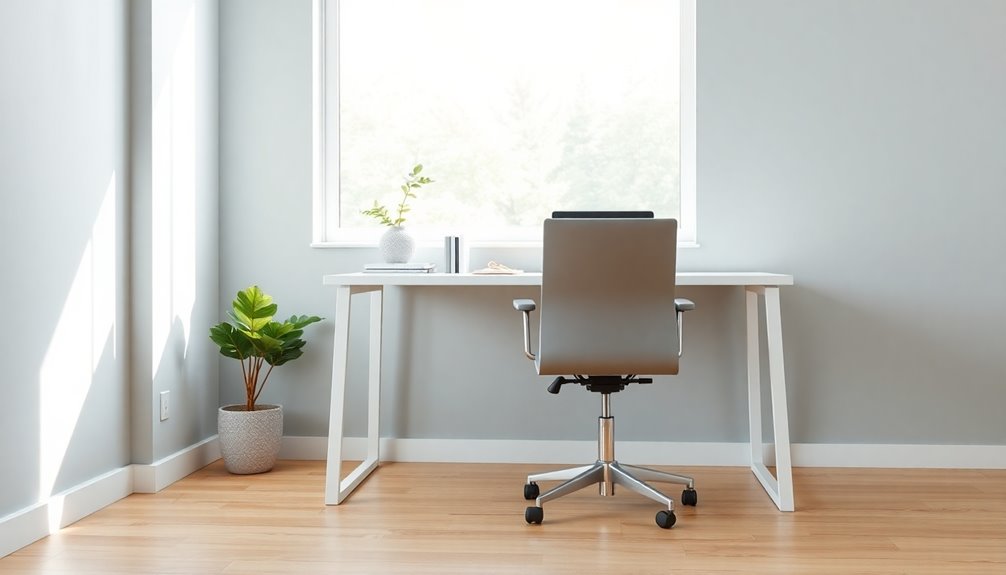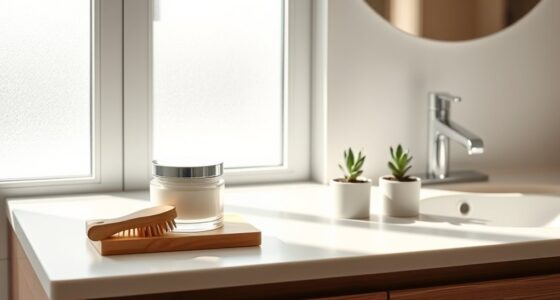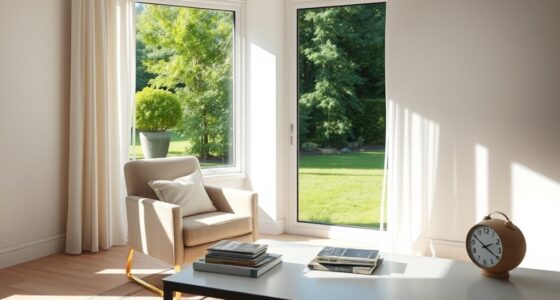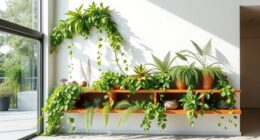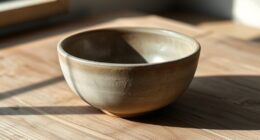To design a minimalist home office for maximum productivity, focus on simplicity and functionality. Use a neutral color palette and incorporate ergonomic furniture to enhance comfort. Keep your workspace organized by removing clutter and limiting personal items. Integrate technology wisely, opting for digital solutions to minimize paper. Add low-maintenance plants for a calming effect and improved air quality. By making these changes, you'll create an efficient work environment. There's plenty more to explore for an even better setup.
Key Takeaways
- Prioritize functional furniture and ergonomic designs to enhance comfort and productivity during long hours of work.
- Utilize a neutral color palette and natural light to create a calming and focused workspace atmosphere.
- Implement effective decluttering strategies, keeping only essential items to maintain an organized and efficient office.
- Incorporate low-maintenance plants to purify the air and add a touch of nature without overwhelming the minimalist aesthetic.
- Leverage technology by using digital tools for project management and note-taking to reduce physical clutter and streamline processes.
Understanding Minimalism in Office Design
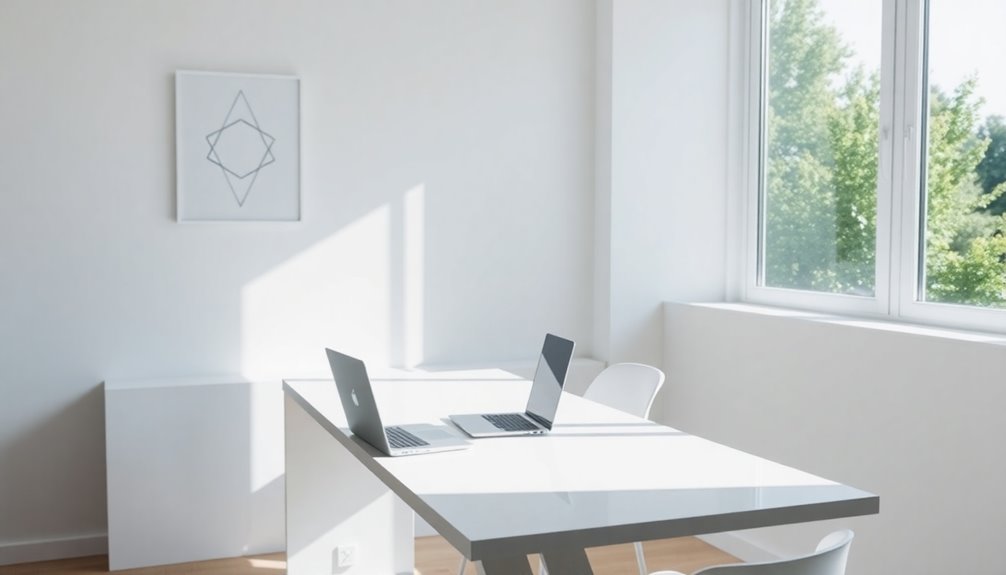
When you embrace minimalism in office design, you create a space that prioritizes simplicity and functionality, which can greatly boost your focus and productivity.
A well-thought-out minimalist office design features a neutral color palette, often incorporating whites, grays, and subtle earth tones that foster a calming atmosphere. This serene environment reduces stress and enhances concentration.
To guarantee an efficient workspace, consider incorporating multi-functional furniture, like desks with built-in storage, which maximizes space while minimizing visual clutter.
Additionally, strategic use of natural light not only brightens your area but also uplifts your mood and productivity.
Regular decluttering and maintaining a minimalist decor guarantee that only essential items remain, markedly reducing distractions and streamlining your work processes.
Planning Your Minimalist Office
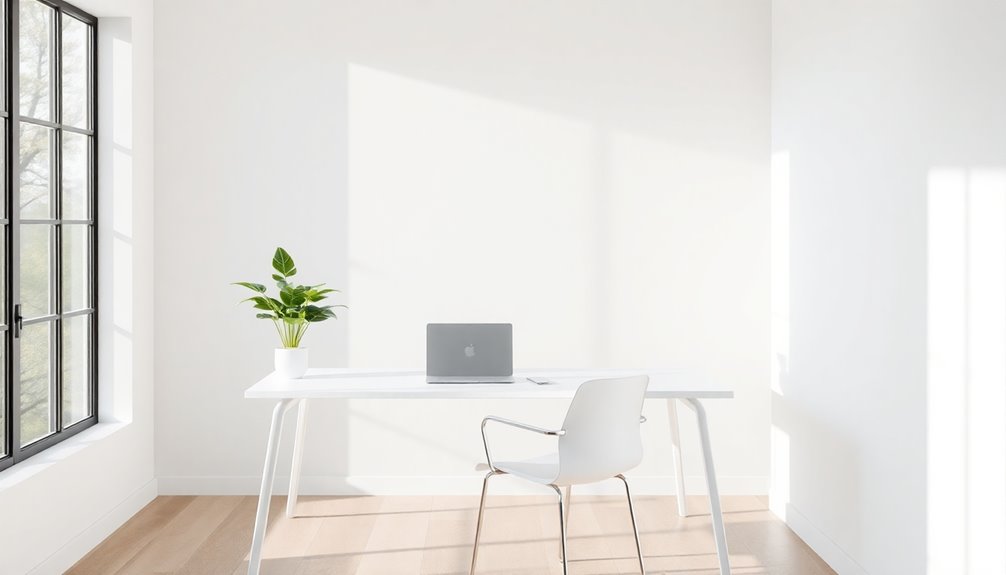
To create an effective minimalist office, you need to assess your workspace needs first. Identify which items are essential for your daily tasks and develop decluttering strategies to keep only what's functional. Incorporating eco-friendly products will further enhance your workspace while aligning with sustainable habits.
Assess Workspace Needs
Evaluating your workspace needs is essential for creating an effective minimalist office. Start by identifying the tools and items you need for daily tasks. Each element should serve a specific purpose. Consider your storage requirements and incorporate minimalist storage solutions, like floating shelves or built-in cabinets, to keep your space organized.
| Task Category | Essential Items | Storage Solutions |
|---|---|---|
| Daily Tasks | Laptop, Notebooks | Floating Shelves |
| Documents | Folders, Pens | Built-in Cabinets |
| Personal Items | Minimal Decor | Drawer Organizers |
Optimize your layout by maximizing natural light and airflow. A neutral color palette can help create a calming atmosphere, enhancing your focus and productivity. Additionally, understanding functional layouts can further improve your office's efficiency.
Decluttering Strategies
Creating a clutter-free workspace starts with a thorough assessment of what you really need.
Use decluttering strategies to categorize your items into essentials, non-essentials, and those to discard or store. Aim to remove at least 30% of your belongings for less clutter.
Implement a digital filing system for paperwork, while using trays or folders for necessary documents to maintain organization. Limit personal items to a few meaningful pieces that adhere to minimalist principles—remember, less is more.
Regularly allocate time for daily desk clearing and weekly reviews to keep your workspace functional.
Finally, utilize multifunctional furniture, like desks with built-in storage, to maximize space efficiency and maintain an organized, serene environment. Additionally, practicing mindful decluttering can help you make intentional choices about what to keep in your workspace.
Essential Elements of a Minimalist Office
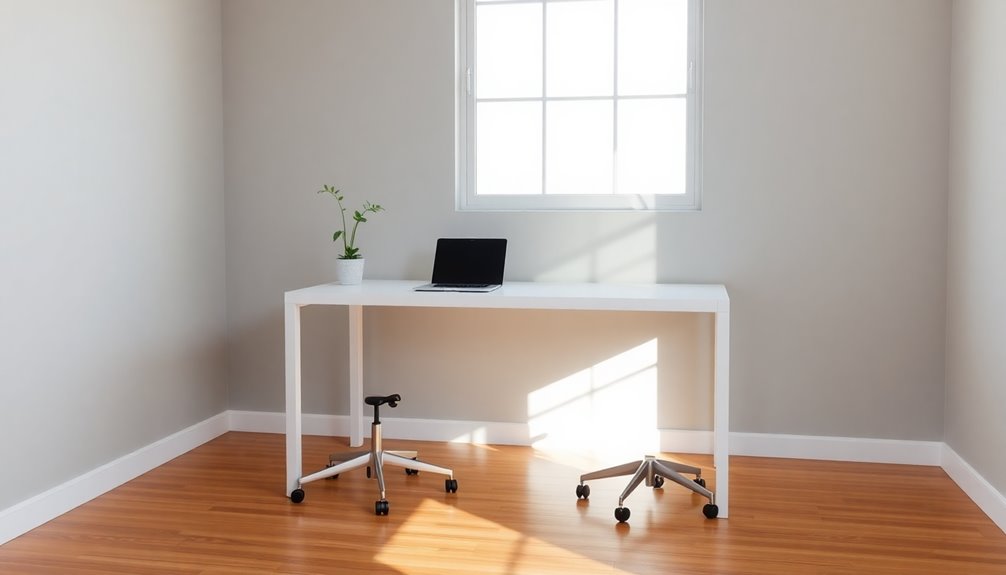
When creating your minimalist office, focus on selecting functional furniture that enhances both comfort and productivity. Choose intentional decor pieces that reflect your style without cluttering the space. This balance will help you maintain an organized and calming work environment. Embracing the elegance of simplicity can lead to a more focused and efficient workspace.
Functional Furniture Selection
To achieve a truly minimalist home office, selecting the right furniture is essential, as it directly impacts both functionality and aesthetics.
Focus on functional pieces with clean lines and a neutral color palette to create a calming atmosphere.
Opt for multifunctional furniture, like desks with built-in storage or convertible workstations, to maximize space and minimize clutter.
Invest in ergonomic chairs that support proper posture, ensuring comfort during long work hours.
Incorporate minimalist storage solutions, such as floating shelves and discreet cabinets, to keep essential items organized without overwhelming the space.
Additionally, consider choosing durable materials that withstand daily use, ensuring your office remains both stylish and practical over time.
Intentional Decor Choices
Intentional decor choices play an essential role in shaping the ambiance of your minimalist home office, as they can enhance both functionality and aesthetic appeal.
To achieve a harmonious and productive space, consider these elements:
- Quality Furniture: Opt for pieces with clean lines and neutral colors that promote a calming atmosphere.
- Minimalist Storage Solutions: Use floating shelves or built-in cabinetry to keep your essentials organized while maintaining a clutter-free environment.
- Meaningful Decor Pieces: Select simple artwork or elegant light fixtures that reflect your personality without overwhelming the minimalist aesthetic.
Incorporating low-maintenance indoor plants boosts mood and creativity, while maximizing natural light with sheer curtains can elevate focus and well-being. Additionally, seasonal arrangements of decor can keep your workspace feeling fresh and aligned with current trends in home decor.
Minimalist Decor and Accessories
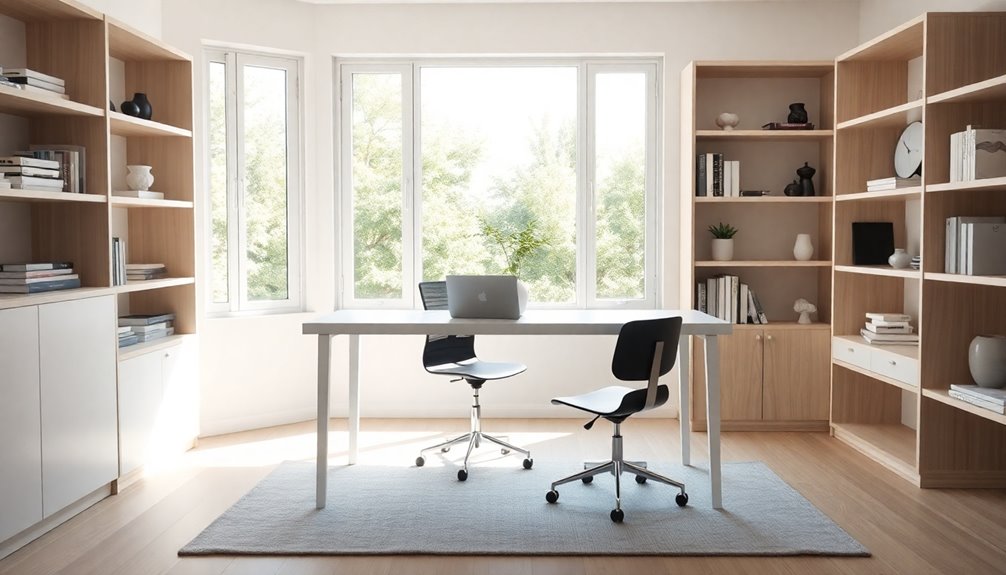
Embracing minimalist decor and accessories transforms your home office into a serene and productive haven.
By adopting a limited color palette of neutral tones like whites and grays, you create a clean aesthetic that minimizes distractions.
Focus on quality over quantity; select a few impactful pieces, such as elegant light fixtures or simple artwork, that reflect your personal style without cluttering the space.
Select a few impactful pieces that showcase your style while maintaining a clean and uncluttered workspace.
Incorporate effective storage solutions, like sleek desk organizers and wall-mounted shelves, to keep your workspace tidy and efficient.
Opt for hidden compartments in furniture to maintain a clutter-free environment, ensuring that only essential items are visible.
This thoughtful approach not only enhances the office's visual appeal but also boosts your productivity. Additionally, using effective wall organization systems can create visual interest while keeping your workspace functional.
Greenery and Plants
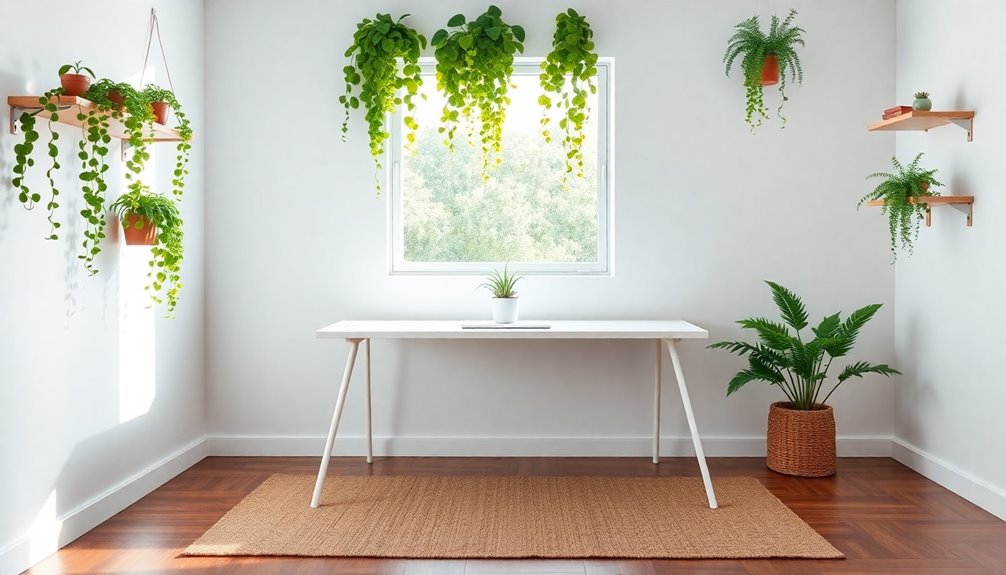
A minimalist home office thrives on simplicity, and adding greenery can elevate this serene space even further.
Incorporating plants not only beautifies your environment but also enhances productivity. Here are three easy ways to incorporate greenery and plants into your minimalist space:
- Choose low-maintenance plants: Opt for succulents or snake plants that purify air and need minimal care, perfect for busy professionals.
- Use modern planters: Select simple, neutral-colored pots to maintain your office's aesthetic while adding a touch of nature.
- Position near natural light: Strategically place plants in well-lit areas to boost their growth and create a calming atmosphere.
Additionally, consider adding non-toxic plants for cats to ensure a safe environment if you have pets, as these plants will keep your workspace inviting and effective without compromising your furry friends' safety.
These elements won't only improve air quality but also reduce stress, making your workspace inviting and effective.
Technology and Minimalism
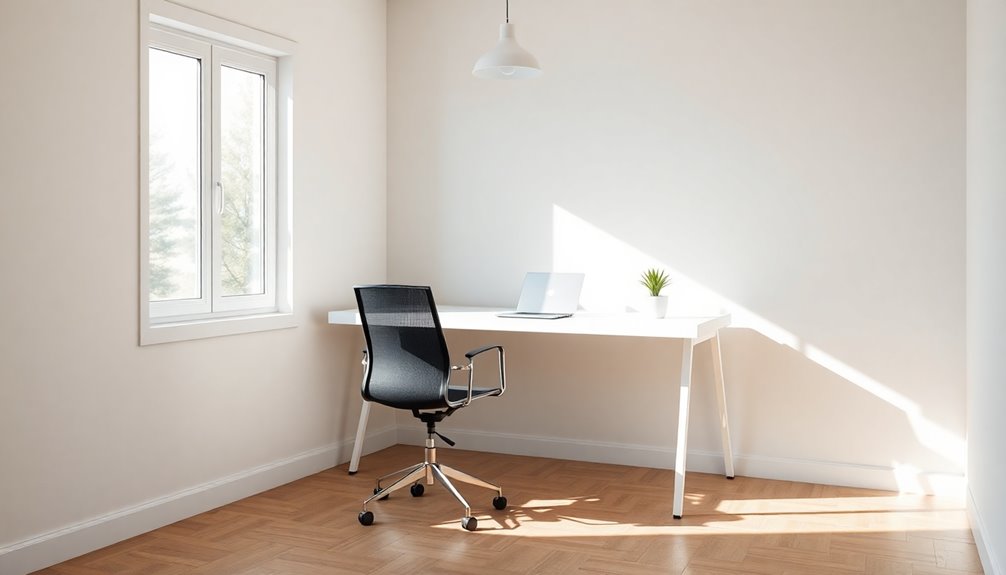
While you design your minimalist home office, integrating technology can greatly enhance your workflow and reduce clutter. By using project management software and digital note-taking apps, you'll minimize physical documents and keep your workspace tidy.
Smart devices like wireless charging stations and voice-activated assistants streamline tasks and eliminate tangled cords, maintaining that clean aesthetic you desire. Cloud storage solutions further support a clutter-free environment, allowing easy access and organization of files without taking up physical space.
Don't forget ergonomic technology, such as adjustable standing desks and monitor arms, which not only improve comfort but also boost productivity. Finally, opt for sleek, minimalist tech peripherals like keyboards and mice to guarantee functionality while keeping your office design cohesive. Additionally, consider incorporating a high refresh rate projector to enhance your video conferencing experience and maintain a visually appealing workspace.
Maintaining Your Minimalist Office
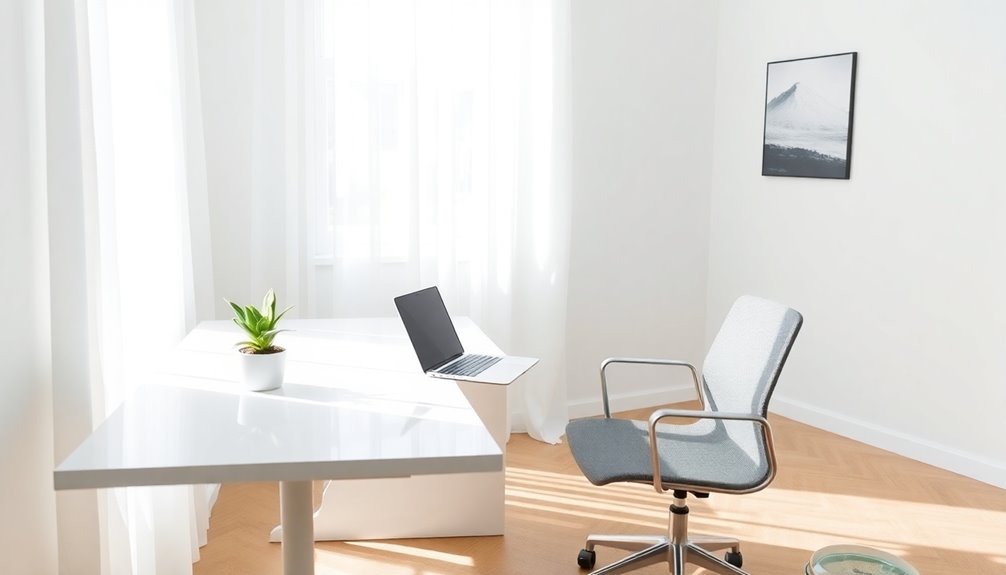
Integrating technology into your minimalist home office sets a strong foundation, but maintaining that streamlined look is just as important.
Integrating technology in your minimalist home office creates a solid base, but keeping it streamlined is crucial for productivity.
Here are three tips to help you keep your space organized and functional:
- Clear your desk daily: At the end of each day, take a moment to clear your desk. This simple habit helps maintain a clean workspace and prevents clutter from building up.
- Manage paperwork promptly: Implement a system for sorting, filing, or digitizing documents immediately. This keeps minimal storage in check and reduces distractions.
- Limit personal items: Display only a few meaningful pieces to maintain order and focus on your essential tasks. Additionally, consider incorporating natural materials into your decor to enhance both the aesthetic and functionality of your workspace.
Minimalist Inspiration
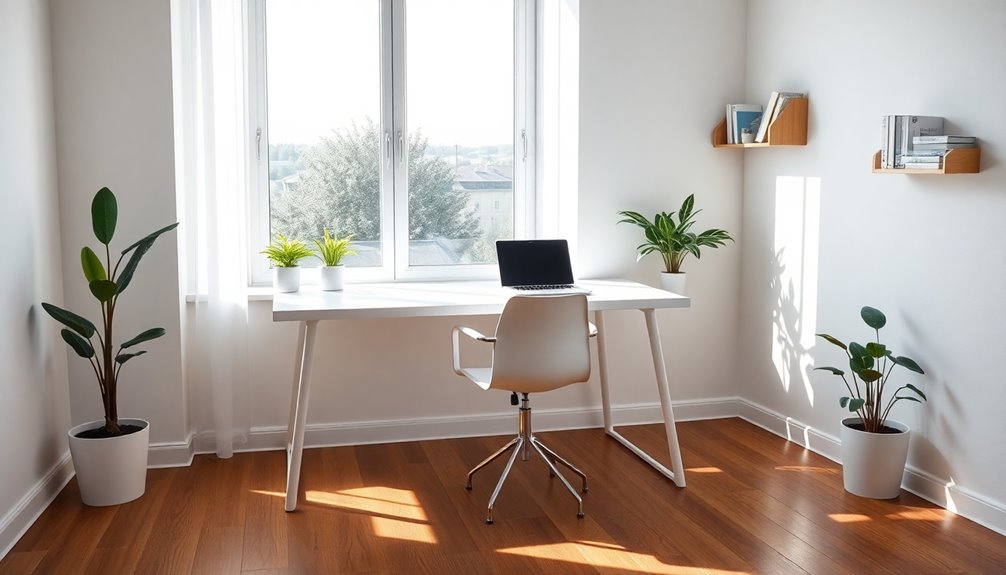
To create a minimalist home office that inspires productivity, focus on simplicity and functionality.
Use a neutral color palette to establish a calming atmosphere that enhances your concentration. Choose multifunctional furniture, like desks with built-in storage, to keep your space tidy and efficient.
Incorporate low-maintenance plants, such as succulents, to improve air quality and add a revitalizing touch of nature to your workspace.
Employ the strategic use of natural light by positioning your desk near large windows or using light-colored materials to make the room feel airy and inviting.
Finally, select a few meaningful decor pieces, like simple artwork or personal mementos, to enrich your minimalist home office without creating clutter.
Frequently Asked Questions
How to Design a Home Office for Productivity?
To design a home office for productivity, start by choosing a well-lit space with plenty of natural light.
Declutter your desk, keeping only essential items to reduce distractions.
Select ergonomic furniture to support your posture and comfort during long hours.
Use multi-functional storage solutions to keep everything organized.
Finally, establish a daily routine to declutter and maintain your workspace, ensuring it remains a productive environment that minimizes stress.
How to Create a Minimalist Home Office?
To create a minimalist home office, start by decluttering your space. Keep only essential items that aid your daily tasks.
Choose a neutral color palette to promote calmness and focus. Select functional furniture like a streamlined desk and an ergonomic chair for comfort.
Add low-maintenance plants to enhance air quality and aesthetics.
Finally, establish daily habits to keep your workspace organized, ensuring clutter doesn't accumulate and disrupt your productivity.
What Is the Best Office Layout for Productivity?
The best office layout for productivity focuses on natural light, so position your desk near a window.
Create distinct zones for focused work, collaboration, and relaxation to enhance efficiency. An open layout encourages communication, boosting team productivity.
Use ergonomic furniture to improve comfort and posture, reducing fatigue.
Finally, keep your space clutter-free with designated storage solutions, which can streamline your workflow and minimize distractions, helping you stay focused on your tasks.
How Do You Maximize Space in a Small Home Office?
To maximize space in your small home office, start by using multi-functional furniture like desks with built-in storage.
Install floating shelves to keep essentials organized and free up desk space.
Position your desk near windows for natural light, creating an inviting atmosphere.
Consider a slim, L-shaped desk to utilize corners effectively.
Finally, commit to a clutter-free strategy by decluttering regularly and using organizers to maintain a tidy, efficient workspace.
Conclusion
In your serene minimalist office, imagine the sunlight streaming through uncluttered windows, casting gentle shadows on a clean, organized desk. Every item you've chosen serves a purpose, sparking creativity and focus. The calmness of your surroundings fuels your productivity, allowing ideas to flow like a tranquil river. By embracing minimalism, you've crafted a space that not only reflects your style but also nurtures your work. Keep it simple, and let your brilliance shine in this peaceful haven.
